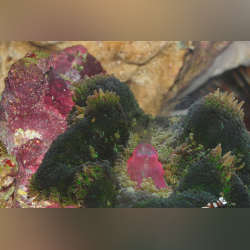Info
Swiftia exserta (Ellis & Solander, 1786)
This very beautiful, colorful animal does not live on light and can therefore unfortunately only be kept in a special aquarium.
And even there, with plenty of food and plankton, feeding is not easy, as even the slightest disturbance can harm the animal.
Recommendation - the coral should be kept in a species-specific tank.
Feeding
Gorgonians do not have zooxanthellae and do not live off light. Azooxanthellate gorgonians do not host symbiotic algae that produce nutrients and energy through photosynthesis.
The pumps should be switched off before feeding. In order for the gorgonian to survive in the aquarium, each individual polyp must be fed sufficiently, i.e. daily or 3-4 times a week. Without feeding, the gorgonian will not survive in the aquarium. The polyps need a certain amount of time to absorb the food (granules or dust food (Ultramarin, Cyclop Eeze) or frozen food (lobster eggs, mysis)). If shrimp and fish are present, they will try to steal the food, so it is essential to feed these cohabitants beforehand.
Newly introduced gorgonian sticks can be stimulated with a liquid food, e.g., PolypLab Polyp, to encourage the individual polyps to open. Only then can feeding be carried out.
The better the individual polyps take up the food provided, the better the growth and reproduction rates will be.
Azooxanthellate corals eat suspensions, marine snow, microplankton, and other organic matter, which is their natural food.
If you cannot and do not want to go to the trouble of feeding them several times a day, you should refrain from buying them. Light is not important, so rather little. Water movement should be pulsating, i.e. rather strong and weak in alternation.
The current should not be too strong when feeding.
Otherwise this gorgonian can tolerate a fairly good current.
Extremely demanding in the long term!
This very beautiful, colorful animal does not live on light and can therefore unfortunately only be kept in a special aquarium.
And even there, with plenty of food and plankton, feeding is not easy, as even the slightest disturbance can harm the animal.
Recommendation - the coral should be kept in a species-specific tank.
Feeding
Gorgonians do not have zooxanthellae and do not live off light. Azooxanthellate gorgonians do not host symbiotic algae that produce nutrients and energy through photosynthesis.
The pumps should be switched off before feeding. In order for the gorgonian to survive in the aquarium, each individual polyp must be fed sufficiently, i.e. daily or 3-4 times a week. Without feeding, the gorgonian will not survive in the aquarium. The polyps need a certain amount of time to absorb the food (granules or dust food (Ultramarin, Cyclop Eeze) or frozen food (lobster eggs, mysis)). If shrimp and fish are present, they will try to steal the food, so it is essential to feed these cohabitants beforehand.
Newly introduced gorgonian sticks can be stimulated with a liquid food, e.g., PolypLab Polyp, to encourage the individual polyps to open. Only then can feeding be carried out.
The better the individual polyps take up the food provided, the better the growth and reproduction rates will be.
Azooxanthellate corals eat suspensions, marine snow, microplankton, and other organic matter, which is their natural food.
If you cannot and do not want to go to the trouble of feeding them several times a day, you should refrain from buying them. Light is not important, so rather little. Water movement should be pulsating, i.e. rather strong and weak in alternation.
The current should not be too strong when feeding.
Otherwise this gorgonian can tolerate a fairly good current.
Extremely demanding in the long term!







 teofrastus
teofrastus














